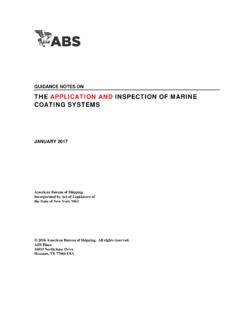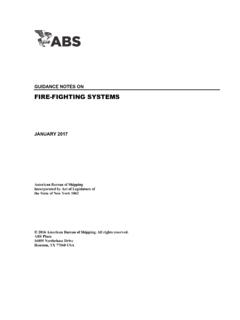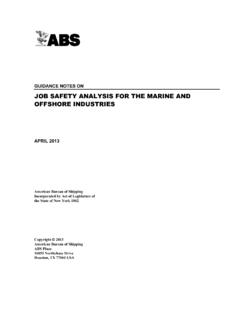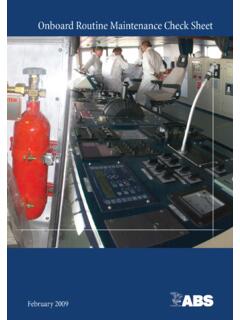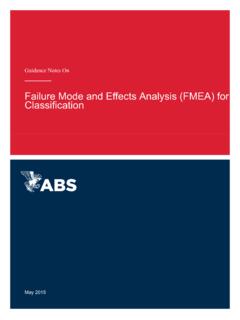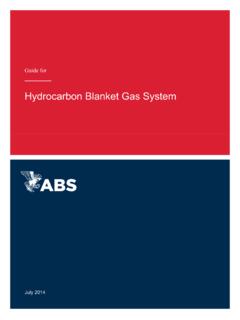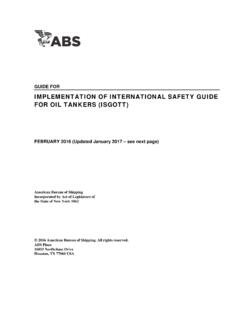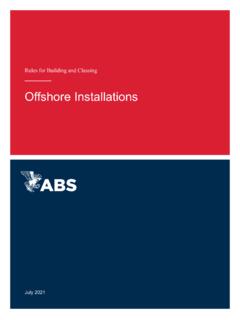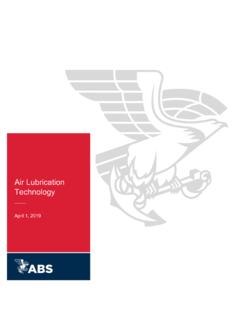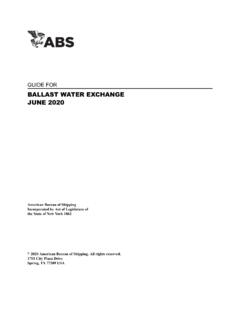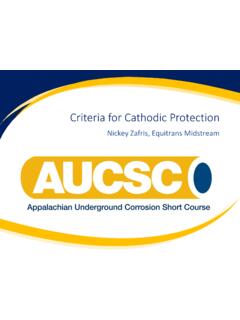Transcription of CATHODIC PROTECTION OF SHIPS - American Bureau of …
1 Guidance Notes on CATHODIC PROTECTION of SHIPS GUIDANCE NOTES ON. CATHODIC PROTECTION OF SHIPS . DECEMBER 2017. American Bureau of Shipping Incorporated by Act of Legislature of the State of New York 1862. 2017 American Bureau of Shipping. All rights reserved. 1701 City Plaza Drive Spring, TX 77389 USA. Foreword Foreword Protective coatings are the most efficient way to protect ship steel structures from corrosion. However, CATHODIC PROTECTION , often in conjunction with protective coatings, is also used to protect immersed parts of bare steel surfaces (including coating damaged areas) from corrosion. This includes the external hull surface and the internal surfaces of tanks, such as ballast tanks. CATHODIC PROTECTION (CP) can be Impressed Current CATHODIC PROTECTION , Galvanic Anode CATHODIC PROTECTION or a combination of both.
2 CATHODIC PROTECTION controls corrosion by supplying direct current to the immersed surface of the structure, thus making the structure a cathode of a cell. The external hull of a ship is exposed to different waters with differing chemistries, which have a profound influence on the CATHODIC PROTECTION . These Guidance Notes on CATHODIC PROTECTION of SHIPS are developed to provide guidelines for ship CATHODIC PROTECTION design, installation, and maintenance. It is a common practice for a ship to have CATHODIC PROTECTION systems installed during its new construction. These Guidance Notes become effective on the first day of the month of publication. Users are advised to check periodically on the ABS website to verify that this version of these Guidance Notes is the most current.
3 We welcome your feedback. Comments or suggestions can be sent electronically by email to Terms of Use The information presented herein is intended solely to assist the reader in the methodologies and/or techniques discussed. These Guidance Notes do not and cannot replace the analysis and/or advice of a qualified professional. It is the responsibility of the reader to perform their own assessment and obtain professional advice. Information contained herein is considered to be pertinent at the time of publication, but may be invalidated as a result of subsequent legislations, regulations, standards, methods, and/or more updated information and the reader assumes full responsibility for compliance. Where there is a conflict between this document and the applicable ABS Rules and Guides, the latter will govern.
4 This publication may not be copied or redistributed in part or in whole without prior written consent from ABS. ii ABS GUIDANCE NOTES ON CATHODIC PROTECTION OF SHIPS . 2017. Table of Contents GUIDANCE NOTES ON. CATHODIC PROTECTION OF SHIPS . CONTENTS. SECTION 1 General .. 1. 1 Scope .. 1. 2 1. 3 Personnel .. 1. 4 Normative References .. 2. 5 Terms and Definitions .. 2. SECTION 2 Design Criteria and Recommendations .. 3. 1 General .. 3. 2 Design Life of CATHODIC PROTECTION 3. 3 CATHODIC PROTECTION Potential .. 3. CATHODIC PROTECTION Potential Criteria .. 3. Detrimental Effects from CATHODIC PROTECTION .. 4. Potential Measurements .. 5. Reference Electrode .. 6. Factors Affecting CATHODIC PROTECTION Potential .. 7. 4 Design Current .. 8. 8. Structure Subdivision and Surface Area Calculations.
5 8. Design Current Density for Bare Steel .. 10. Design Current Density for Coated 10. Current Demand .. 11. 5 Circuit Resistance .. 12. 6 Anode Resistance Calculations .. 13. For Slender Anodes Mounted at Least m ( in.) Offset from the Structure Steel Surface .. 13. Long Flush Mounted Anodes on the Structure Steel Surface where Length 4 14. Short Flat Plate Mounted Flush on the Structure Steel Surface where Length < 4 Width .. 14. 7 Anode Current Output and Operating Life .. 14. 14. Service Temperature Effect .. 14. Minimum Net Weight of Anode .. 15. Anode Life .. 15. Anode Resistance at the End of Life .. 15. ABS GUIDANCE NOTES ON CATHODIC PROTECTION OF SHIPS . 2017 iii 8 CATHODIC PROTECTION Systems ..17. General .. 17. CATHODIC PROTECTION System Selection.
6 17. Installation Consideration .. 19. 9 Electrical Continuity ..19. General .. 19. Shaft Ground Assembly .. 19. Rudder (and Other Appendages) Ground .. 20. TABLE 1 Summary of Potentials versus Ag/AgCl/Seawater Reference Electrode Recommended for the CATHODIC PROTECTION of Various Metals in Seawater ..4. TABLE 2 Common Reference Electrodes and Their Potentials and Temperature Coefficients ..7. TABLE 3 Typical Design Current TABLE 4 Values of coating Breakdown Factors for Conventional Paint Systems for Ship Hulls ..11. TABLE 5 Typical Average Current Densities of Coated Hulls for CATHODIC PROTECTION ..11. TABLE 6 Comparison of Galvanic Anodes and Impressed Current CATHODIC PROTECTION Systems for Ship Hulls ..18. FIGURE 1 Typical Arrangement for Two Impressed Current Systems for Ship Hulls.
7 9. FIGURE 2 Illustration of Anode Sizes ..17. FIGURE 3 Typical Arrangement for Shaft Grounding and Monitoring ..20. SECTION 3 Galvanic Anodes System .. 21. 1 General ..21. 2 Design Considerations ..21. 3 Electrochemical Properties of Anodes ..21. General .. 21. Material Chemical Composition .. 22. Potential .. 22. Current Capacity .. 22. Anode Consumption Rate .. 22. 4 Anode Materials and Their Properties ..23. General .. 23. Zinc Anodes .. 23. Aluminum 24. Magnesium Anodes .. 25. 5 Anode Arrangement ..26. Anode Connection .. 26. Anode Distribution on Hull .. 26. Anodes near the Bow .. 27. Anodes at the Stern .. 27. PROTECTION for Propellers and Shafts .. 28. Anodes for Rudders .. 28. iv ABS GUIDANCE NOTES ON CATHODIC PROTECTION OF SHIPS . 2017. Anodes for Sea Chests and Scoop Openings.
8 28. CATHODIC PROTECTION of Heat Exchangers, Condensers, and Tubing .. 29. 6 CATHODIC PROTECTION of Internal 29. 29. Protective Current 29. Anode Selection and Weight .. 30. Arrangement of 30. Anode Attachment .. 30. coating .. 32. Lay-up Period .. 32. 7 Installation of Galvanic Anodes .. 32. TABLE 1 Chemical Composition of Zinc Anodes, weight % .. 23. TABLE 2 Typical Electrochemical Properties of Zinc Anodes in Seawater .. 24. TABLE 3 Chemical Composition of Aluminum Anodes, weight % .. 24. TABLE 4 Typical Properties of Aluminum Anodes in Normal Operation Conditions (Anode Current Density, Temperature, and Seawater) .. 25. TABLE 5 Chemical Composition for Magnesium Alloy Anodes, weight %.. 25. TABLE 6 Typical Electrochemical Properties of Magnesium Anodes at Ambient Temperatures 5 C-25 C (41 F-77 F).
9 25. TABLE 7 Recommended Initial, Final and Mean Design Current Densities for Bared Steel Surface Exposed to Seawater with a Range of Surface Water Temperatures .. 29. FIGURE 1 Arrangement of Galvanic Anodes on the Stern .. 28. FIGURE 2 Example of Installation of a Galvanic Anode in a Tank Using Clamps .. 31. SECTION 4 Impressed Current 33. 1 General .. 33. 2 ICCP System Components .. 33. Transformer Rectifier Power Source, Monitoring, and Control 33. Anodes .. 35. Reference Electrode .. 38. Wiring and Connections .. 38. Stuffing Tube(s) .. 38. Cofferdams .. 39. Dielectric Shield .. 39. Arrangement of Anodes and Reference Electrodes .. 41. 3 Considerations .. 42. ABS GUIDANCE NOTES ON CATHODIC PROTECTION OF SHIPS . 2017 v TABLE 1 Properties of Impressed Current TABLE 2 Typical Minimum Distance from Anode Edge to Conventional coating .
10 40. FIGURE 1 Externally Attached Impressed Current Anode with Cofferdam ..35. FIGURE 2 Typical Recessed Impressed Current Anode with Cofferdam ..36. FIGURE 3 Typical Reference Electrode Mountings with Cofferdam Arrangement ..39. FIGURE 4 Example of the Arrangement of Anodes and Reference Electrodes ..41. SECTION 5 Commissioning, Operation, and Maintenance .. 44. 1 General ..44. 2 Potential Measurement ..44. 3 Commissioning: Galvanic Systems ..44. 4 Commissioning: Impressed Current Visual 44. Pre-energizing Measurements .. 45. Initial Energizing .. 45. Performance Assessment .. 45. 5 Operation and General .. 45. Galvanic Anode Systems .. 45. Impressed Current Systems .. 46. 6 Drydocking Period ..46. 7 Fitting Out and Lay-up ..46. General .. 46. Fitting-out Period.
